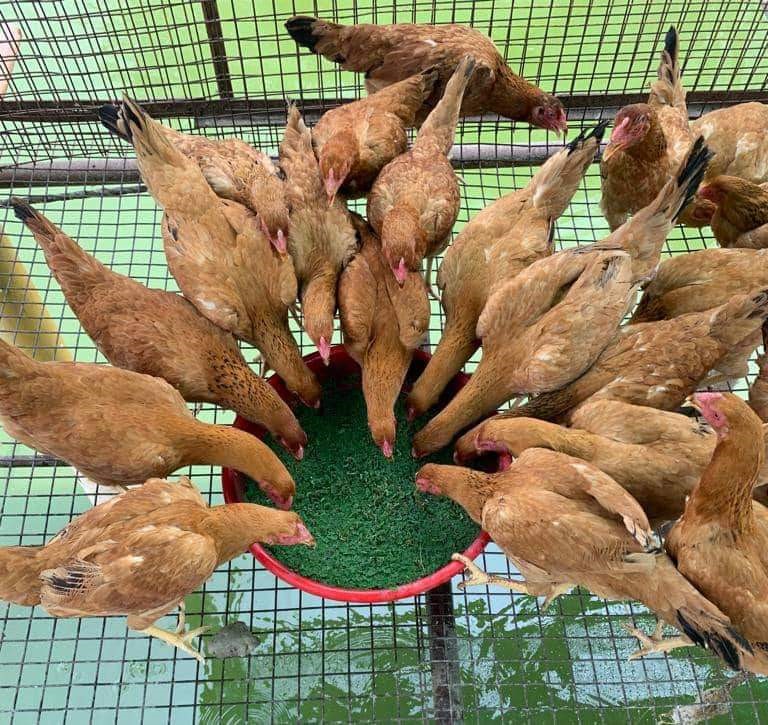Types of Different Feeding Methodes
General Principles of Feeding in Poultry
- Poultry feed should contain all essential nutrients like protein, fat, carbohydrates, energy, fibre, minerals, vitamins & moisture in proper proportion depending on type, category of bird and season.
- The feed should be free from all pathogenic organisms like salmonella, E coli, etc & also devoid of toxins like gossypol, aflatoxin, etc.
- The finished feed should not be stocked for more than 1 to 1.5 months to avoid loss of nutrients and to prevent development of rancidity, fungal growth, moulds & also spoilage by rodents.
- Formation of cakes in feeders should be avoided to stop the growth of fungus and moulds in feeders.
- Feeders should not be filled more than 1/3rd to ½ level to control wastage.
- The nutrient level should be changed as per need of season.
- Minimum two feedings in the form of all mash or pellets are good for optimum consumption and to ensure correct intake of micronutrients.
- Poultry birds at any stage should not be under or over fed.
Methods of Feeding
1. Whole grain feeding method:
Whole ungrounded grains are used. Grain fusing is the oldest system practiced under range system of rearing chicken and this feeding system is being introduced once again in the organic system of farming. This is not suitable for large scale farming. Birds fed with whole grains have bigger gizzard. A well balanced whole grain feeding may help the health of the bird by developing a healthier digestive system.
Disadvantage:
Feed is not balanced and is mostly deficient in amino acids. In meat birds, it takes a longer period to reach the required weight and in Layer, the egg production is lower.
Advantages:
This is a very easy method of feeding the birds & cheaper too.
2. Mash feeding method:
Many feed ingredients are in ground form. The essence of a "mash" is that at least, each bite of feed is a balanced diet containing all the known nutrients in finely ground form. But, birds find the finely ground mashes unpalatable; they are too dry and sticky. Therefore, mashes composed of materials of medium particle size improve the bird's ability to eat them readily.
3. Pellet feeding method:
The mash may be compressed by running it through specialized equipment to form pellets of varying sizes. Crushed pellets are used to feed younger birds. Pellet feeding are classified as Hard or soft pellets based on the appearance and also classified as steamed or cold pellets.
Different Feeding System:
1. Choice feeding:
Under choice feeding, the birds are usually offered a choice between three types of feedstuff i.e. energy source like grain, protein source (e.g soyabean meal, fishmeal, meat meat etc) along with vitamins and minerals. In case of laying birds, calcium source in granular form (shells) is preferred.
Advantages:
1. The cost of grinding and mixing is minimized.
2. The bird can select its balance of nutrient to meet its particular physiological requirement
Disadvantage:
Needs more numbers of feeders and more feeding space and thereby, more floor space and the system cannot be followed in cage system.
3. Restricted Feeding:
Restricted feeding is a must by preventing excess fat deposition to control the body weight and to delay sexual maturity.
The various methods of restriction are:
1.Limiting the feed time: a. Skip a day feeding b. Skip two days feeding method
2. Diluting the ration by using substances with low food values.
3. Energy restriction
4. Protein restriction
5. Quantity restriction
4. Sex Separate Feeding/ Male Separate Feeding:
The breeder males must be fed Protein with diet having 13-14% protein only because high protein diet will affect the sperm quality as well as the semen volume. Therefore, sex separate feeding of breeder males needs to be followed. The male and female feeds are offered in separate feed hoppers on slat and deep litter system.
5. Phase Feeding Programme:
Providing feed in phased manner by dividing the growth period and thus, providing diets that are more closely meet the birds nutrient requirements is known as phase feeding. Phase feeding is described as a strategy to change the diet several times to meet the production requirement for each period. According to BIS, 2007 the broilers are fed in three phases (Prestarter, starter and finisher) and layers are fed in starter, grower, layer phase I and layer phase II phases.
Broiler feeding at different phase: (as per BIS, 2007):
| Characteristic | Pre starter | Starter | Finisher |
|---|---|---|---|
| ME (Kcal/kg) | 3000 | 3100 | 3200 |
| CP% | 23 | 22 | 20 |
| Ca % | 1 | 1 | 1 |
| Available P % | 0.45 | 0.45 | 0.45 |
| Lysine % | 1.3 | 1.2 | 1 |
| Methionine % | 0.5 | 0.5 | 0.45 |
Layer feeding at different phase (as per BIS, 2007):
| Nutrient | Chick 0 – 8 weeks |
Grower 9 – 20 weeks |
Layer Phase –I 21-45 weeks |
Layer Phase –II 46-72 weeks |
|---|---|---|---|---|
| ME min Kcal/Kg | 2800 | 2500 | 2600 | 2400 |
| Crude Protein Min % | 20 | 16 | 18 | 16 |
| Crude fibre max % | 7 | 9 | 9 | 10 |
| Methionine min% | 0.4 | 0.35 | 0.35 | 0.30 |
| Calcium min% | 1 | 1 | 3 | |
| Avail. phosphorous min% | 0.7 | 0.65 | 0.65 | |
| Lysine min% | 1.0 | 0.7 | 0.7 |

Feeding

